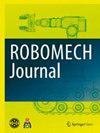基于传感器输出噪声协方差矩阵的扩展卡尔曼滤波姿态估计
IF 1.7
Q3 INSTRUMENTS & INSTRUMENTATION
引用次数: 7
摘要
本文提出了一种基于传感器输出的利用噪声协方差矩阵进行姿态估计的扩展卡尔曼滤波器。紧凑轻便的九轴运动传感器被广泛用于医疗福利和体育等各个领域的运动分析。九轴运动传感器包括三轴陀螺仪、三轴加速度计和三轴磁力计。从三个传感器获得的信息对于使用卡尔曼滤波器估计关节角度是有用的。扩展卡尔曼滤波器被广泛用于状态估计,因为它可以用较小的计算负载来估计状态。然而,在扩展卡尔曼滤波器中确定过程和观测噪声协方差矩阵是复杂的。基于传感器输出,为本研究找到了扩展卡尔曼滤波器中的噪声协方差矩阵。陀螺仪输出中会出现姿势变化,因为关节的旋转运动会产生人体运动。因此,基于陀螺仪输出确定了过程噪声协方差矩阵。基于加速度计和磁力计的输出确定了观测噪声协方差矩阵,因为这两个传感器的输出被用作观测值。在一项实验室实验中,在参与者行走时,使用光学3D运动分析系统和九轴运动传感器测量了三名参与者的下肢关节角度。基于传感器输出,使用具有噪声协方差矩阵的扩展卡尔曼滤波器估计的下肢关节角度通常与从光学3D运动分析系统获得的结果一致。此外,当参与者在原地跑步约100秒时,使用九轴运动传感器测量下肢关节角度。实验结果证明了该方法对人体姿态估计的有效性。本文章由计算机程序翻译,如有差异,请以英文原文为准。
Pose estimation by extended Kalman filter using noise covariance matrices based on sensor output
This paper presents an extended Kalman filter for pose estimation using noise covariance matrices based on sensor output. Compact and lightweight nine-axis motion sensors are used for motion analysis in widely various fields such as medical welfare and sports. A nine-axis motion sensor includes a three-axis gyroscope, a three-axis accelerometer, and a three-axis magnetometer. Information obtained from the three sensors is useful for estimating joint angles using the Kalman filter. The extended Kalman filter is used widely for state estimation because it can estimate the status with a small computational load. However, determining the process and observation noise covariance matrices in the extended Kalman filter is complicated. The noise covariance matrices in the extended Kalman filter were found for this study based on the sensor output. Postural change appears in the gyroscope output because the rotational motion of the joints produces human movement. Therefore, the process noise covariance matrix was determined based on the gyroscope output. An observation noise covariance matrix was determined based on the accelerometer and magnetometer output because the two sensors’ outputs were used as observation values. During a laboratory experiment, the lower limb joint angles of three participants were measured using an optical 3D motion analysis system and nine-axis motion sensors while participants were walking. The lower limb joint angles estimated using the extended Kalman filter with noise covariance matrices based on sensor output were generally consistent with results obtained from the optical 3D motion analysis system. Furthermore, the lower limb joint angles were measured using nine-axis motion sensors while participants were running in place for about 100 s. The experiment results demonstrated the effectiveness of the proposed method for human pose estimation.
求助全文
通过发布文献求助,成功后即可免费获取论文全文。
去求助
来源期刊

ROBOMECH Journal
Mathematics-Control and Optimization
CiteScore
3.20
自引率
7.10%
发文量
21
审稿时长
13 weeks
期刊介绍:
ROBOMECH Journal focuses on advanced technologies and practical applications in the field of Robotics and Mechatronics. This field is driven by the steadily growing research, development and consumer demand for robots and systems. Advanced robots have been working in medical and hazardous environments, such as space and the deep sea as well as in the manufacturing environment. The scope of the journal includes but is not limited to: 1. Modeling and design 2. System integration 3. Actuators and sensors 4. Intelligent control 5. Artificial intelligence 6. Machine learning 7. Robotics 8. Manufacturing 9. Motion control 10. Vibration and noise control 11. Micro/nano devices and optoelectronics systems 12. Automotive systems 13. Applications for extreme and/or hazardous environments 14. Other applications
 求助内容:
求助内容: 应助结果提醒方式:
应助结果提醒方式:


